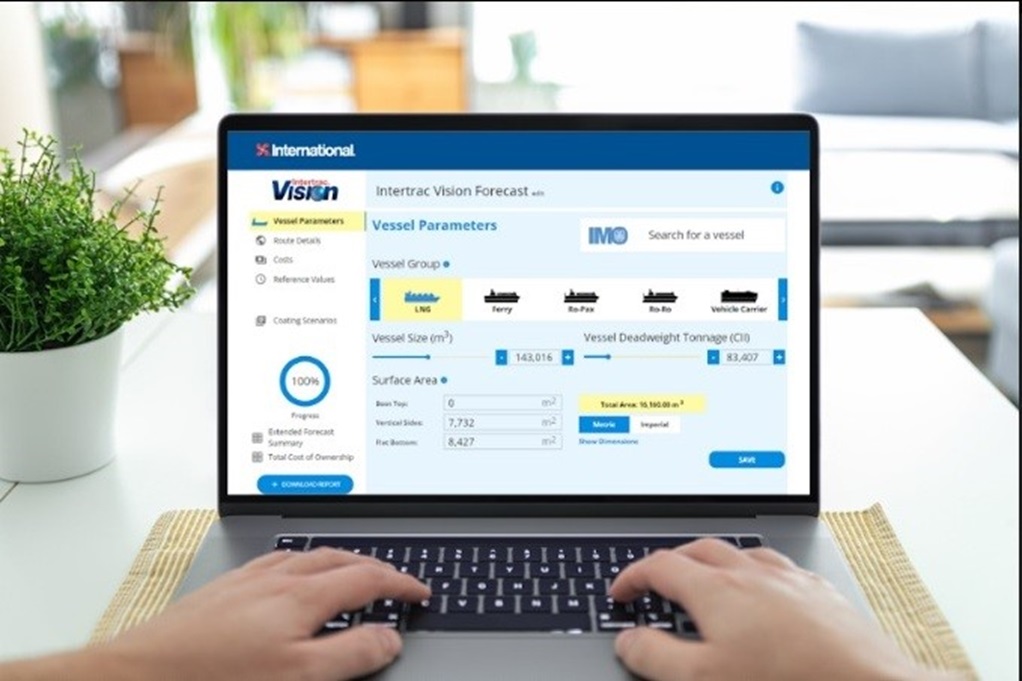AkzoNobel’s International® marine coatings brand has announced a series of updates to Intertrac® Vision, a revolutionary digital forecasting tool. The latest enhancements include CII rating prediction, EU ETS cost impact and detailed breakdowns of cost savings across multiple dry-dockings, all designed to further support data-driven decision making on fouling control coatings for global vessel operators.
Intertrac® Vision analyzes insights from more than 200,000 drydocks and 10,000 vessel operations. Harnessing this extensive track record and pairing it with cutting-edge machine learning modelling, the tool forecasts the contribution of coating performance for a vessel’s in-service period and evaluates the return on investment based on the specified vessel type and operational scenarios.
The tool enables vessel operators to make more informed decisions on fouling control coatings which can help contribute to lower fuel consumption and reduced CO2 emissions. The total cost of ownership summary has also been implemented in this recent update, providing insight into the return on investment as well as giving detailed cost contribution for each element of the drydocking cycle.
Other significant new features include the option to forecast over a 120-month cycle, either as two 60-month consecutive dockings or one continuous period. This accommodates the needs of vessel owners and operators to view the longer-term benefits of proper coating selection.
With the expansion of EU Emissions Trading Systems (EU ETS) in January 2024 and the implementation of FuelEU regulation from January 2025, vessel owners and operators are now subject to more rigorous regulations. Consequently, there is a growing need from vessel operators for extensive data and reliable insights to facilitate improved decision-making processes on vessel operations.
A recent Lloyds List survey found that more than 59% of shipowners consider coatings to be one of the best decarbonization measures they can take to comply with the International Marine Organisation’s Carbon Intensity Indicator and Energy Efficiency Existing Ship Index.
Barry Kidd, Vessel Performance Manager at AkzoNobel, said: “Intertrac® was developed to empower shipowners and operators with bespoke insights to help make more informed decisions on vessel performance. Our technical experts understand how fouling challenges and vessel operations vary across trading routes. When combined with our technical expertise, the Intertrac® Vision tool provides vessel operators with a greater understanding of where improvements can be made to their vessel operations which in turn drives better investment decisions. We’re proud to announce that this next generation of Intertrac® Vision will equip customers with even greater insights to help them navigate the ever-evolving regulatory landscape.”
Earlier this year, AkzoNobel demonstrated the predictive capabilities of Intertrac® Vision in a whitepaper where it accurately forecasted the performance of a globally trading VLCC vessel over a five-year docking period. The results demonstrated the reliability of Intertrac® Vision’s data-driven insights to accurately predict the vessels’ performance to within 1% of actual figures when measured in line with ISO19030.
To learn more about Intertrac® Vision, please get in touch with your International® Paint representative to book a consultation for your fleet. Visit the International® booth B5.423 at SMM Hamburg on 3-6 September 2024.
Source: AkzoNobel.
Tags: AkzoNobel, Coatings, Marine



Recent Posts
Hyundai Glovis to Retrofit Seven PCTCs with Avikus AI Navigation System
Super Terminais orders three more Konecranes Gottwald ESP.10 Mobile Harbor cranes
Covestro and HGK Shipping Extend Partnership to 2040 with Focus on Wind-Assisted Vessel Retrofit
Artemis Technologies Successfully Demonstrates 100 Percent Electric Crew Transfer Vessel at Aberdeen Offshore Wind Farm
IACS Council Advances Decarbonisation, Digitalisation and Governance Priorities at C91 Meeting in Beijing
Japan Launches Major R&D Project to Advance Shipbuilding with Alternative Fuels
EU Adopts Emissions Standards for Low Carbon Hydrogen to Bolster Clean Energy Market
Trafigura to Implement ZeroNorth’s AI Platform Across Global Fleet